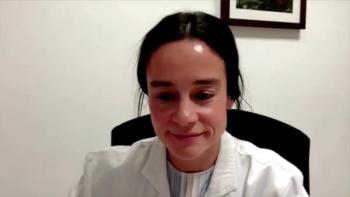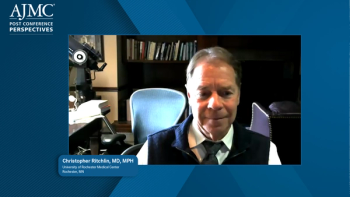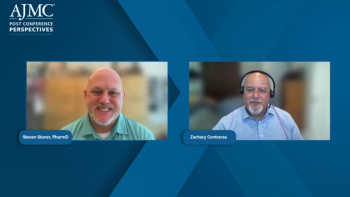
MM and the Limitations of RCT Data
Dr Baljević explain some of the limitations physicians can come across with applying randomized clinical trial (RCT) data to MM treatment.
Episodes in this series

Ryan Haumschild, PharmD, MS, MBA: Now let’s talk about the use of real-world evidence in multiple myeloma. We have randomized clinical trials; we have data from phase 2 and phase 3 studies that drive FDA approvals of treatment regimens. As we know, they often influence the guidelines that we help create, or the clinical pathway positioning in our payer and integrated delivery network arms. But we know that there are some limitations in randomized clinical trials. We even heard Roy and Jay talk about adherence, and maybe sometimes something looks great in a clinical trial but does not translate to the real world. And there are some other instances that we’ve seen, so as we consider that, I’m curious, particularly in multiple myeloma, what are some of the limitations of randomized clinical trials? Muhamed, maybe you can start us off, how does that study population differ from the real world? And what should we be considering in some of that translation as we start to prioritize agents and therapy?
Muhamed Baljević, MD, FACP: This is increasingly becoming a very important thing to understand well, and proactively, so that we can hopefully start changing the pendulum and start learning in step with the times. It’s interesting in our field, I can tell you, and the colleagues will know this, before we had a phase 3 study that proved survival and PFS [progression-free survival] benefit for VRd [bortezomib, lenalidomide, and dexamethasone] vs RV [lenalidomide and bortezomib], for example in newly diagnosed patients, we were using that regimen for 8 years before that study read out. On one hand, we are very good at thinking about and sensing what may be better and what may be more efficacious for patients. But at the same time, your question is pointing out 2 realities and the problems of how well all those data correlate to the real-world experience.
The reality of the matter is that the vast majority of patients with myeloma get their treatment in community hospitals and smaller health care settings. If you look at where the data have been produced, historically speaking, it’s been produced primarily at tertiary care–type academic centers. What that leads to is unintended biases in terms of selection, in terms of performance. One of the painful things that I always think of is some orphan disease populations, like plasma cell leukemia, or myeloma with central nervous system expansion and involvement. They get excluded from the trials, so we barely have any randomized data to tell us how to treat those patients. And this is telling because work has been done in this area, and it’s somewhat concerning to see that the median duration of therapy in the real-world data was only about 70% of that in the clinical trial observations, so that’s concerning.
At the beginning we talked about some of these PIs [proteasome inhibitors] and IMiDs [immunomodulatory drugs] and CD30 agents, etc. But when you look at some of these analyses that were done and try to understand, for example, a drug like carfilzomib, from the phase 3 clinical studies, you have duration of therapy on average being 9 or so months, but in the real-world reports, it’s 2 to 4 months maximum. If you look at easier agents to use, for example, proteasome inhibitors in combination with alkylators, the median duration of time on therapy hasn’t even been reached in the clinical studies, but in the real world, it’s about 5 months. If you look at the oral proteasome inhibitors or IMiD triplets, and this is something that Roy alluded to earlier, the average time that they’re used in phase 3 trials is 15, almost 16 months, and yet in the real-world experience, it’s 5 or 6 months. This is really concerning.
What we need to start doing is also try to understand that we increasingly need to run clinical trials in the real-world setting, and expand the reach of the studies that are being done in the real-world experience. This is so you can try to get the feel for what it means to have a whole system behind you and a whole team making sure that you’re doing your laboratory tests, making sure you’re reporting your symptoms, making sure that you have your log, making sure that you call with the smallest issue, which obviously allows us to proactively manage it. Versus in the real-world setting, where some of those things may not necessarily happen. Altogether, when we consider a question like this, we also need to respect the fact that because of the longevity of these patients, quality of outcome metrics is also increasingly becoming highly important. In fact, the major societies that help advocate and administer care for patients with cancer, such as ASH [American Society of Hematology] and ASCO [American Society of Clinical Oncology], etc, advocacy groups, they’re increasingly raising awareness of the so-called patient-reported outcomes and quality of outcome metrics. What we need to do also is start including those more and more, so that we can capture things like financial toxicity, quality of life, overall burden of adverse effects, and quality of symptom management. And that is bound to become increasingly more important as we get better and better at controlling the disease.
We must look at the history of how we design these randomized phase 3 trials and look at the comparator arms. I believe only in recent times we have started really appreciating the fact that some of the historical comparator arms are not necessarily the best things that you should offer the patients in these situations. Lo and behold, it almost seems as if they were designed for success, and they were designed for that superiority that was expected. The reality is when you have a highly relapsed/refractory patient, the doublet shouldn’t be a comparator arm. At least in those patients who are fit enough, we simply shouldn’t be comparing to doublets. We should be comparing to other triplets, because as we mentioned earlier, we’re starting to do a better job actually, from this year, they consciously made an effort of splitting the regimens into those that are proven and tested in 1 to 3 prior lines, and then those in line 3 lines and more, and then also penta-refractory. At least to highlight to providers, where the data were generated. As we design these trials, and quite frankly advocacy groups and patient groups have done a good job, voicing their opinions, and we too. When I’m choosing clinical trials for our center, I’m always actively looking, am I going to be OK if my patient gets randomized to the control arm, and they get something potentially substandard that I am clinically aware that I personally would never put them on? So recently, I would say we are doing a better job at consciously designing trials in a better way, so that we can in a more realistic and fair way, get an answer of what might be better.
Ryan Haumschild, PharmD, MS, MBA: I like how you brought that up, because designing trials is key, but we know that not everyone’s going to design it that way. I won’t say bias, but they want to compare it sometimes to a standard of care that might be out of date, in my opinion, or not the latest treatment.
This transcript has been edited for clarity.
Newsletter
Stay ahead of policy, cost, and value—subscribe to AJMC for expert insights at the intersection of clinical care and health economics.










































